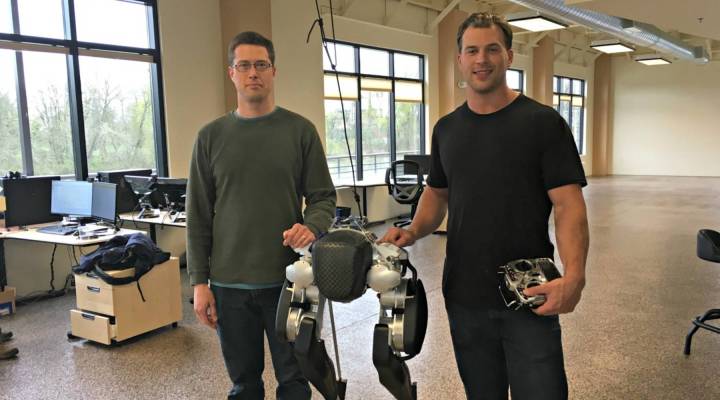
Growth and balance in Corvallis, Oregon

Corvallis, Oregon, is a college town. It’s a small city of about 50,000 people, home Oregon State University. The area votes Democratic — it’s a sanctuary city with a sanctuary campus in the heart of very blue state.
Corvallis is wrestling with a changing economy, trying to balance issues of town, gown and growth — mainly how to use some of the college brainpower to create a startup hub, without damaging the city’s culture.
That culture is what keeps a lot of locals happy. The cute coffee shops selling locally roasted beans, the airy riverfront restaurants brewing beer in the back, the thriving public schools … it’s all part of what makes Corvallis feel homey and accessible.
“There’s a group of people in town who would like Corvallis to stay the way it is or the way it was 20 or 40 years ago,” Mayor Biff Traber said. Traber is a former software executive who took office about two years ago. As nice as Corvallis is now, he’s one of many who would like to see things change and grow.
RAIN — the Regional Accelerator and Innovation Network — is right there with him. The organization invests in startups and entrepreneurs in the area in partnership with the university, which provides mentoring through the OSU Advantage Accelerator program.
Caroline Cummings, a venture catalyst with RAIN, works as a matchmaker for people, programs and capital.
“Over the last two years, since we’ve been tracking the economic impact of RAIN, there’s been about 50 companies that have gone through the accelerator programs,” Cummings said. “Those 50 companies have generated about 5 million in revenue, and they’ve raised about 10 million in capital. And that’s created 105 jobs.”
The big success story for RAIN and OSU is Agility Robotics. The company makes a legged robot called Cassie, named for the bird Cassowary. Cassie looks like a headless, wingless ostrich. She can walk naturally, with the gait of huge bird or a horse’s back legs.
There’s probably an array of solutions for how you get those packages to your doorstep,” Hurst said. “You see the drones … some wheeled vehicles, but none of those are going to handle stops, or crowded urban environments, and legs certainly can.”
Cassie can step over a flower pot and avoid the family dog. And when it comes to how legged robots might be used in the future, the possibilities are still beyond imagination. “It’s like imagining what smartphones will do for us … back when they imagined them for the original “Star Trek,” Hurst said.
Cassie’s mobility is valuable as a research tool and an investment. For Hurst and his two co-founders, money wasn’t hard to come by. Lots of venture capitalists want to fund robotics companies.
But they needed something else, too. “We’re not looking for just dollars,” Hurst said, “we’re looking for help and partnerships. You know, I’ve been a professor, but never started a company before.”
That’s where the accelerator and RAIN come in. Oregon State has a stake in the company — Agility Robotics’ technology is licensed from the university. Hurst and his team can continue to get business advice and mentoring from the accelerator and tap into the talent pool coming out of the school.
All that makes staying in Oregon, as opposed to picking up and moving to Silicon Valley, very attractive.
“It’s not a competitive environment, it’s not where one person’s success detracts from another’s,” Hurst said. “A rising tide lifts all boats. And I really, really appreciate that culture here.”
And Agility Robotics got that. Their company is right by the river in Albany Oregon, 10 miles from Corvallis. The rent in Albany is cheaper, and there’s more space for bigger businesses.
Mayor Biff Traber would, of course, love Agility and businesses like it to set up shop within his city’s limits. He’s working to encourage growth for businesses like Agility Robotics, some of which have moved into the former Hewlett Packard campus in Corvallis.
In the ’90s, HP employed about 10,000 people in Corvallis. Now, fewer than 2,000 people work there, but the company leases out this building space. A few startups have already moved in, and the OSU Advantage Accelerator is expanding its offices into the HP building.
Still, Traber needs to reconcile that growth with Corvallis’ quaint vibe. It’s a hard balance to strike, especially given that Oregon State has added 10,000 students in the past two decades, leading to a housing crunch and a rush to build more apartments and multifamily homes.
If Traber can find a happy medium for Corvallis, then he’s well on his way to solving some pretty nice problems to have.
There’s a lot happening in the world. Through it all, Marketplace is here for you.
You rely on Marketplace to break down the world’s events and tell you how it affects you in a fact-based, approachable way. We rely on your financial support to keep making that possible.
Your donation today powers the independent journalism that you rely on. For just $5/month, you can help sustain Marketplace so we can keep reporting on the things that matter to you.


















